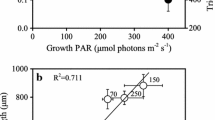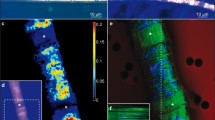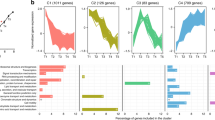Abstract
Cultures of the cyanobacterium Microcystis firma show rhythmic uptake and release of ammonia under conditions of carbon limitation. The massive removal of ammonia from the medium during the first light phase has little impact on the intracellular pH: a pH shift of less than 0.2 U towards the alkaline can be measured by in vivo 31P NMR. Furthermore, the energy status of the cells remains regulated. In vivo 15N NMR of M. firma, cultivated either with labelled nitrate or ammonia as the sole nitrogen source, reveals only gradual differences in the pool of free amino acids. Additionally both cultivation types show γ-aminobutyric acid, acid amides and yet unassigned secondary metabolites as nitrogen storing compounds. Investigating the incorporation of nitrogen under carbon limitation, however, only the amide nitrogen of glutamine is found permanently labelled in situ. While transamination reactions are blocked, nitrate reduction to ammonia can still proceed. Cation exchange processes in the cell wall are considered regarding the ammonia disappearance in the first phase, and the control of ammonia uptake is discussed with respect to the avoidance of intracellular toxification.
Similar content being viewed by others
Abbreviations
- GABA:
-
γ-aminobutyric acid
- GOGAT:
-
glutamate synthase
- GS:
-
glutamine synthetase
- MDP:
-
methylene diphosphonate
- MOPSO:
-
3-(N-morpholino)-2-hydroxy-propanesulfonic acid
- NDPS:
-
nucieoside diphosphosugars
- NOE:
-
nuclear Overhauser effect
- NMR:
-
nuclear magnetic resonance
References
Abarzua S, Schiewer U, Schüler H, Kleinhempel C (1988) Ammonia rhythm in batch cultures of the cyanobacterium Microcystis firma: evocation in dependence of external conditions. J Plant Physiol 133:585–591
Abarzua S, Nietz K (1990) NHinf4/sup+ release by non-growing cultures of the cyanobacterium Microcystis firma. Physiol Plant 78:135–139
Allen MS, McBurney MI, Van Soest PJ (1985) Cation-exchange capacity of plant cell walls at neutral pH. J Sci Food Agric 36:1065–1072
Boussiba S, Resch CM, Gibson J (1984) Ammonia uptake and retention in some cyanobacteria. Arch Microbiol 138:287–292
Callies R, Altenburger R, Mayer A, Grimme LH, Leibfritz D (1990) A new illumination system for in vivo NMR spectroscopy. J Magn Reson 90:561–566
Choi BS, Roberts JE, Evans JNS, Roberts MF (1986) Nitrogen metabolism in Methanobacterium thermoautotrophicum: A solution and solid-state 15N NMR study. Biochemistry 25:2243–2248
Crist RH, Martin JR, Guptill PW, Eslinger JM (1990) Interactions of metals and protons with algae. 2. Ion exchange in adsorption and metal displacement by protons. Environ Sci Technol 24:337–342
Di Martino Rigano V, Martello A, Di Martino C, Rigano C (1985) Effect of CO2 and phosphate deprivation on the control of nitrate, nitrite and ammonium metabolism in Chlorella. Physiol Plant 63:241–246
Harris RK (1983) Nuclear magnetic resonance spectroscopy. Pitman, London Marshfield
Kallas T, Dahlquist FW (1981) Phosphorus-31 nuclear magnetic resonance analysis of internal pH during photosynthesis in the cyanobacterium Synechococcus. Biochemistry 20:5900–5907
Köppen C (1989) NMR-Zeitreihenanalytik und zeitlich aufgelöste in vivo 31P NMR Spektroskopie im Sekundenbereich. Thesis, University of Bremen, Faculty of Physics
Kugel H, Mayer A, Kirst GO, Leibfritz D (1990) The energy requirements of pH homeostasis define the limits of pH regulation — A model. Biochim Biophys Acta 1054:33–40
Küsel AC, Kuhn W, Sianoudis J, Grimme LH, Leibfritz D, Mayer A (1989) N-15 in vivo NMR spectroscopic investigation of nitrogen deprived cell suspensions of the green alga Chlorella fusca. Arch Microbiol 151:434–438
Küsel AC, Sianoudis J, Leibfritz D, Grimme LH, Mayer A (1990) The dependence of the cytoplasmic pH in aerobic and anaerobic cells of the green algae Chlorella fusca and Chlorella vulgaris on the pH of the medium as determined by 31P in vivo NMR spectroscopy. Arch Microbiol 153:254–258
Lara C, Romero JM, Coronil T, Buerrero MG (1987) 6 Interactions between photosynthetic nitrate assimilation and CO2 fixation in cyanobacteria. Prokaryotes. In: Ullrich WR (ed) Inorganic nitrogen metabolism. Springer, Berlin Heidelberg New York, pp 45–52
Martin F (1985) Monitoring plant metabolism by 13C, 15N and 14N nuclear magnetic resonance spectroscopy. A review of the applications to algae, fungi and higher plants. Physiol Veg 23:463–490
Mitsumori F, Ito O (1984) A simple photoirradiation method for biological samples in NMR probes and its application to photosynthesizing green algae. J Magn Reson 60:106–108
Ohmori M, Oh-hama T, Furihata K, Miyachi S (1986) Effect of ammonia on cellular pH of Anabaena cylindrica determined with 31P NMR spectroscopy. Plant Cell Physiol 27:563–566
Packer L, Spath S, Martin J-B, Roby C, Bligny R (1987) 23Na and 31P NMR studies on the effects of salt stress on the freshwater cyanobacterium Synechococcus 6311. Arch Biochem Biophys 256:354–361
Schiewer U, Baader G (1982) Pelagic NH4 rhythm independent of the sediment in eutrophic shallow waters. Int Rev Ges Hydrobiol 67:845–850
Schiewer U, Arndt H, Baader G, Ballin G, Börner R, Evert F-K, Georgi F, Heerkloss R, Jost G, Kell V, Krüger B, Walter T (1986) The bounds and potential effects of NHinf4/sup+ (loading) on the pelagic system of a baltic estuary. Limnologica 17:7–28
Sianoudis J, Küsel AC, Naujokat T, Offermann W, Mayer A, Grimme LH, Leibfritz D (1985) Respirational activity of Chlorella fusca monitored by in vivo P-31 NMR. Eur Biophys J 13:89–97
Sianoudis J, Küsel AC, Mayer A, Grimme LH, Leibfritz D (1987) The cytoplasmatic pH in photosynthesizing cells of the green alga Chlorella fusca, measured by 31-P-NMR spectroscopy. Arch Microbiol 147:25–29
Solomonson LP, Spehar AM (1979) Model for the regulation of nitrate assimilation. Nature 265:373–375
Thoma WJ, Gleason FK (1987) In vivo effects of photosynthesis inhibitors in Synechococcus as determined by 31P NMR spectroscopy. Biochemistry 26:2510–2515
Thorpe TA, Bagh K, Cutler AJ, Dunstan DI, McIntyre DD, Vogel HJ (1989) A 14N and 15N nuclear magnetic resonance study of nitrogen metabolism in shoot-forming cultures of white spruce (Picea glauca) buds. Plant Physiol 91:193–202
Turpin DH, Elfrifi IR, Birch DG, Weger HG, Holmes JJ (1988) Interactions between photosynthesis, respiration, and nitrogen assimilation in microalgae. Can J Bot 66:2083–2097
Author information
Authors and Affiliations
Additional information
For convenience, the term “ammonia” is used throughout to denote ammonia or ammonium ion when there is no good evidence as to which chemical species is involved
Rights and permissions
About this article
Cite this article
Altenburger, R., Abarzua, S., Callies, R. et al. Ammonia rhythm in Microcystis firma studied by in vivo 15N and 31P NMR spectroscopy. Arch. Microbiol. 156, 471–476 (1991). https://doi.org/10.1007/BF00245394
Received:
Accepted:
Published:
Issue Date:
DOI: https://doi.org/10.1007/BF00245394




